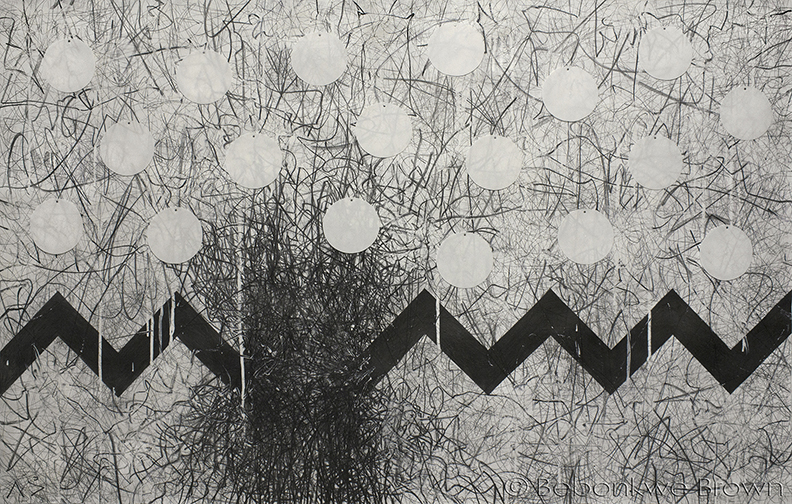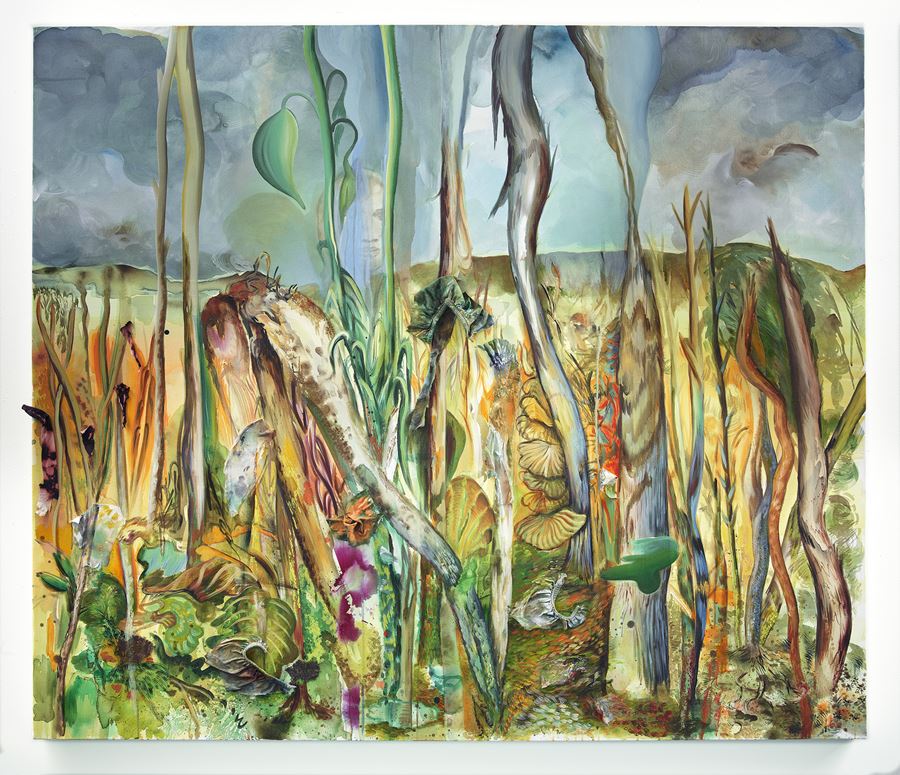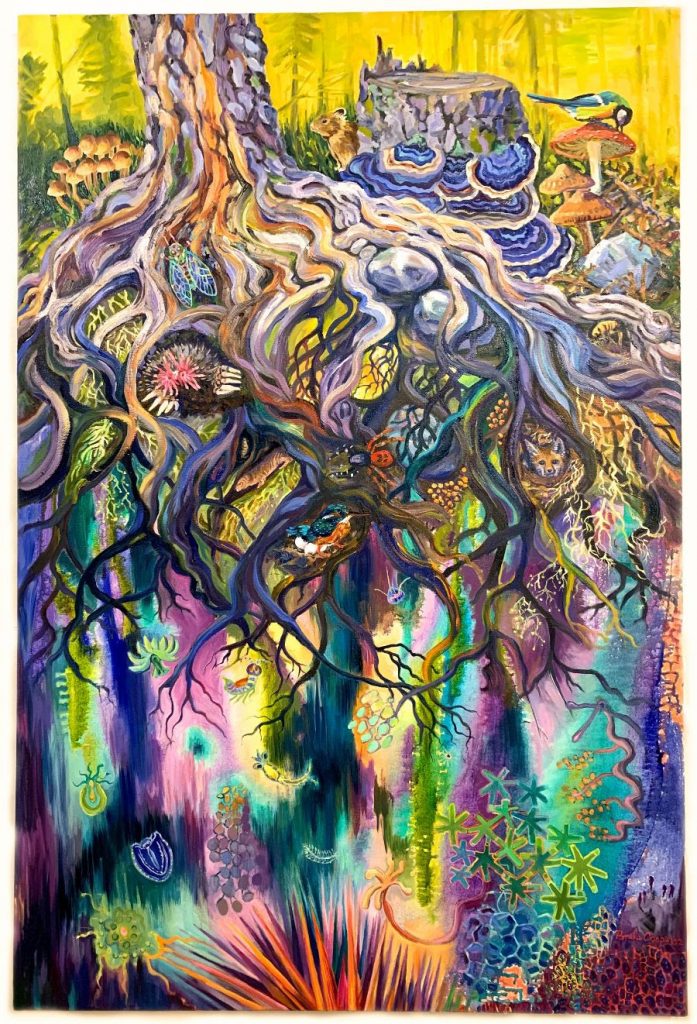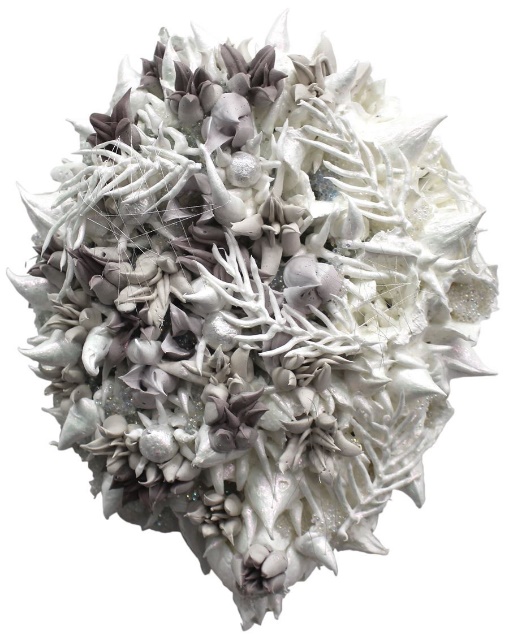Featured Project: with curator Sue Spaid

Tessa Grundon, Invasive Species, 2018-2021/2022, Asiatic Bittersweet root systems and border fencing, dimensions variable.
The group show Fragile Rainbow: Traversing Habitats at the Williamsburg Art and Historical Center in Brooklyn includes paintings, sculptures, videos, and installations addressing environmental issues by more than fifty artists from the New York City region who are members of ecoartspace. The title is based on Claire McConaughy’s oil painting, Fragile Rainbow, referencing both hope and loss. The show runs from May 7th through June 4th, 2022. Curator Sue Spaid elaborates on this large-scale group show.
What is your curatorial vision for this show and can you walk us briefly through the show?
As it turns out, organizing a members’ exhibition is a bit more complicated than curating a typical group exhibition. For one, I knew only a handful of the artists, though I had encountered many more during ecoartspace’s regular zoom presentations whereby four to five artists introduce their practice in the framework of trees, fungi, plastic, water, or abstraction (multi-monthly zoom sessions are typically thematic). Moreover, this exhibition came together rather rapidly as the gallery’s availability wasn’t secured until March. Ecoartspace founder Patricia Watts identified over fifty local artists who submitted up to six artworks along with installation instructions. Not only was I responsible for selecting artworks and creating meaningful relationships amidst this unusual space replete with radiators, windows and doors, but I had to track whether there was sufficient space to include artworks by as many members as possible.
Technicalities aside, once the artworks were selected, the idea to organize them in terms of habitat and interconnectedness seemed obvious. Even more wonderful was the way everything came together during installation, enabling the exhibition itself to exemplify interconnected habitat. Simulating a grove, one wall features paintings replete with trees, branches, flowers, fungi, roots, animals, and seeds, including pendulous cigar tree seeds (Catalpa speciosa). Two-sided drawings dangling from wires that span three columns fortuitously mimic marks and gestures visible in nearby artworks. As a result, notions of entanglement and sinuousness abound. Continuing the tradition of Plains Indian women’s drawing abstract geometric motifs, Indigenous artist Bebonkwe’s post-traumatic entanglement (Opal) proffers a sober counterpoint to this exhibition’s surfeit of exuberant renderings like Pamela Casper’s Forest Spectacle and Deborah Wasserman’s Migrating Crop.


Deborah Wasserman, Migrating Crop, 2020, Oil on panel, 60 x 70 inches.

Pamela Casper, Forest Spectacle, 2022, Oil and acrylic on canvas, 60 x 40 inches.
As if to straddle land and water, a sinuous fence comprised of discarded beauty boxes not only evokes a pinkish river dragon, but it provides surprising opportunities for viewing nearby forest paintings. Hung high, an 8-feet long rainbow spanning a mysterious waterway conveys vulnerability and optimism. Artworks assembled beneath and to its right address smoke-filled sea haze, the network of streams feeding the longest Finger Lake, glacier formation, cloud mapping, swamp life, jellyfish maneuvers, bleached corals, and Manhattan’s receding shorelines.
Although such exhibitions fail to avail equitable real estate, special ensembles magnify the presence of smaller artworks. For example, a vertical line of six small sun prints hangs to the left of a large window where three circular transparent cityscapes dangle adjacent Astronomia, a tiny golden painting that serves as our sun. Complementing this sunny spot are four modest dusk- and nightscapes nearby.
Bursting with spiky fragments, dozens of artworks made from bark, leaves, mushrooms, seeds, feathers, plastic bits, roots, woven fibers, video imagery, acrylic paint, mugwort, horse hair, branches and rawhide insinuate habitat for nearby caribou, deer, birds, squirrels, spiders, and insects. A life-size nuclear bomb adjacent a red healing carpet embedded with hundreds of mini-milagros connects this exhibition’s message of fragility and hopefulness to WAH Center’s mission of peace through art.
Installed in an adjacent gallery, several conceptual artworks feature rusting copper salts, land art protecting vulnerable forests, a Pacific Island undergoing sea rise, plastic refuse smothering an artist, a chessboard overlaying leaves, composted food exhibiting decay, and a spiral wetland in the making. Fragile Rainbows: Traversing Habitats extends outdoors with Stacy Levy’s Tide Flowers in Domino Park and visitors returning the bladderwrack to the shoreline.

Seren Morey, Seraph, 2020, Ultralight acrylic, pigment dispersions, thread and glass beads on panel, 12 x 9 x 4 inches.
Fragile Rainbow: Traversing Habitats presented by ecoartspace at the The WAH Center 135 Broadway in Williamsburg, Brooklyn, New York, through June 4th, 2022 Curated by Sue Spaid
Artists include: Elizabeth Albert, M. Annenberg, L.C. Armstrong, Nancy Azara, Jeannine Bardo, Jude Norris – Bebonkwe, Lois Bender, Jean Brennan, Michele Brody, Diane Burko, Pamela Casper, Margaret Cogswell, Elisabeth Condon, Katie De Groot, Kate Dodd, Rosalyn Driscoll, Rachel Frank, Alice Garik, Tessa Grundon, Andrea Haenggi, Kristin Jones, Natalya Khorover, Jennifer Kotter, Laurie Lambrecht, Rita Leduc, Stacy Levy, Lenore Malen, Claire McConaughy, Lauren Rosenthal McManus, Emmy Mikelson, Patricia Miranda, Seren Morey, Carol Padberg, Tracy Penn, Aviva Rahmani, Leah Raintree, Laziza Rakhimova, Bonnie Ralston, Lisa Reindorf, Eleni Smolen, Anne-Katrin Spiess, Priscilla Stadler, Linda Stillman, Mary Ann Strandell, Debra Swack, Sandra Taggart, Kate Temple, Deborah Wasserman, Riva Weinstein, Linda Weintraub, Stephen Whisler, Marion Wilson, Chin Chih Yang, Millicent Young.
Sue Spaid is a Cincinnati-based philosopher, Ph. D., who has been active in the artworld as a collector, curator, art writer, university lecturer, and museum director since 1984. The author of five books on art and ecology, Spaid’s most recent monograph is The Philosophy of Curatorial Practice: Between Work and World (2020), published by Bloomsbury Academic. In 2017, Spaid curated “Ecovention Europe: Art to Transform Ecologies, 1957-2017,” a sixty-year survey of artists’ ecological efforts throughout Europe, accompanied by a book of the same name, published by Hedendaagse Kunst De Domijnen. In 2013, her traveling exhibition “Green Acres: Artists Farming Fields, Greenhouses, and Abandoned Lots,” funded by an Emily Hall Tremaine Exhibition Award, concluded its tour at the American University Museum and Arlington Arts Center. While Curator at the Contemporary Arts Center, Cincinnati (1999-2002), she authored the book Ecovention: Current Art to Transform Ecologies that accompanied the 2002 exhibition she co-curated with Amy Lipton (1956-2020), former east coast curator of ecoartspace. https://suespaid.info